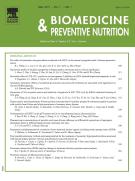Mechanism underlying the anti-inflammatory effect of sulphated polysaccharide from Padina tetrastromatica against carrageenan induced paw edema in rats - 26/11/11


Abstract |
The anti-inflammatory effect of sulphated polysaccharide (SP) isolated from an algae Padina tetrastromatica was studied. Even though the polysaccharide was found to be a fucan, the composition of this polysaccharide is different from those reported and the mechanism underlying the anti-inflammatory effect also has not been reported so far; perhaps this might be the first report in this regard. Paw edema in rats was induced by injecting 0.1mL, 1% carrageenan suspension in 0.9% NaCl solution into the sub-plantar tissue of the right hind paw. SP was given intraperitoneally (i.p), 1 hour before the injection of carrageenan. Carrageenan caused a significant increase in the activity of inflammatory marker enzymes like lipoxygenases (LOX) and cyclooxygenase (COX) in peripheral blood mononuclear cells (PBMC) and increased the concentration of serum ceruloplasmin and myeloperoxidase (MPO). SP pre-treatment when compared to the reference drug significantly reduced the concentration of COX and LOX in PBMC, ceruloplasmin and MPO in serum and also inhibited the iNOS and COX-2 expression at mRNA level. As this polysaccharide has high anti-inflammatory activity when compared to the anti-inflammatory drug diclofenac, this natural biomolecule could be recommended as a new effective drug for inflammation.
Le texte complet de cet article est disponible en PDF.Keywords : Sulphated polysaccharide, Inflammation, LOX, COX, INOS
Plan
Vol 1 - N° 4
P. 294-301 - octobre 2011 Retour au numéroBienvenue sur EM-consulte, la référence des professionnels de santé.
L’accès au texte intégral de cet article nécessite un abonnement.
Déjà abonné à cette revue ?

